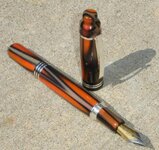There really is no conspiracy. If you purchased one of my custom pens and wanted to replace a part, you would have a hard time finding a tap or die to do so as well. This is because of the ability to build a pen on a whim. With a metal lathe, there is no rules as to what diameter, pitch or angle that a thread needs to be. I can spin down a rod to any size I feel comfortable. I don't need to use any calipers or calculations. I can then thread the rod with a single point bit to whatever angle and depth looks good to me. I can take a piece of that rod about 2" long or so..eyeball is fine because it isn't important. I part the rod. I chuck the small piece, grab a die grinder and cut four notches across the threads. Now I have a tap that perfectly matches the rod. The rod becomes the nib and finial and the tap is used in the cap. Pens are not like cars, needing some parts to be somewhat universal. Now if you are a large pen company, in the design stage, you may start of somewhat similar. You need all the parts for that line to be the same, but they don't have to be usable with another line of pens, and maybe you don't want people to intermix different types of pens together, so you make yours a bit different. If you were to get into doing vintage repairs, then you would find out quickly that you need to purchase 10,000 taps and die's, or else you need to get a metal lathe, figure out the diameter and pitch of the threads, and make your own taps. Pens are like art, and there doesn't have to be rules in art. You go with what you feel as you build it. That's why it's special.

